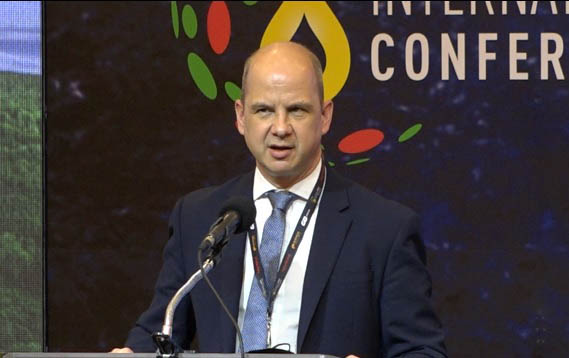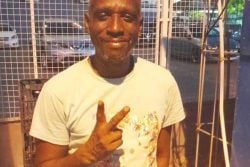By Lakhram Bhagirat
Guyana’s government is moving ahead with its plan to reap the environmental benefits of the county’s forests by putting at least 8 million carbon credits for sale by July, according to climate change specialist Kevin Hogan.
Hogan, who was an adviser to former President Bharrat Jagdeo during the era he focused heavily on climate change and environmental preservation, currently works with the Irfaan Ali administration and is attached to the Office of the President.
Hogan is the founder of Climate Action Partner-ships and has a career that spans from working at the highest level in the United Nations to working with small nations and individuals to foster better environmental practices.
“We expect Guyana…will be able to issue about eight to 10 million (carbon) credits in the early days of ART-TREES [Architecture for REDD+ Environmental Excellence Standard]. We hope to issue a lot more in future years as certain uncertainty and complicated mathematical formulae drop away after the market matures, but in the early days, about eight to 10 million carbon credits,” Hogan said while delivering an address on the carbon credit market at the international oil and gas conference on Thursday.
The conference concluded yesterday at the Marriott Hotel in Kingston.
Carbon credits are referred to as “hall passes” greenhouse gas emissions. Forests serve as carbon sinks and with approximately 85% of its landmass covered in forests coupled with a low deforestation rate, Guyana is looking to further market its carbon absorption capabilities.
Guyana alone stores about 19.5 billion tonnes of carbon in its forests that are estimated to be valued at US$40 billion to US$54 billion annually, according to President Irfaan Ali.
Now, with the sale of carbon credits, Guyana is aiming to earn significant sums from its carbon storage potential. By purchasing carbon credits, companies and governments with high CO2 emission rates are granted permission to generate one tonne of CO2 emissions per credit.
The sale of carbon credits is not a foreign concept to Guyana since it had the second-largest such agreement with Norway under the Low Carbon Development Strategy (LCDS) piloted by Jagdeo. Under that carbon credit agreement, Guyana earned over US$212 million which was used for various transitional projects.
Hogan, who worked with the Guyanese government during the Guyana-Norway pact, said that the deal was the second-largest agreement of its kind in the world with only Brazil ahead. However, if one were to look at the deal from a per capita standpoint then Guyana would be ahead of the world.
“The credits funded the SME (small and micro-entrepreneurs) programme (under which) well over 2000 jobs were created. 4500 people were trained in low carbon opportunities. In the hinterland, the Amerindian Development Fund did something similar with 180 communities having community development plans funded. Something like 1500-1600 jobs were created and 1000s of people trained.
“The Cunha Canal, which some of you will be familiar with, was rehabilitated. This protects farmers, farming land, businesses (and) homes from the impacts of climate change. All of these [were] funded from carbon credits but the truth is it was a slow start but then once it got moving it then slowed down again,” Hogan told the conference.
He added that the funding from Norway was also used for the land titling programme which was slowed down over the past few years but is expected to restart.
The Amazon Forest is the largest in the world and Guyana, Suriname, French Guiana and Brazil share the Guiana Shield which stores approximately 20% of the world’s fresh water and about 18% of the world’s tropical forest carbon.
Hogan said that with global temperatures rising steeply and the commitment to limit global warming to 1.5 degrees Celsius, the world needs to start putting more financial value on the forests. He explained that based on current trends, the forests are worth more “dead” than alive since there are no mechanisms to earn from the eco-services they provide.
“The Amazon Rain-forest, on the other hand, left standing contributes massively to the importance of the world (and) massively to the economy of the world. But left standing is essentially worth nothing. Whereas when people farm or they mine or they build infrastructure and the trees go down, it’s worth a lot more destroyed than it’s worth standing up. Of course, it’s more complex than that but that is essentially the role of the carbon markets to change that equation,” he related.
Knowledge and leadership
Hogan said that with the 2008 LCDS, Guyana envisioned the service it can provide the world since its CO2 emissions are relatively low. He noted that the knowledge of the importance of the country’s forests was translated into leadership and Guyana is now at the second phase of being in a position to earn.
Since 2009 Guyana has been advocating for the incentivizing of forests and the establishment of a market where this can be done. A lot of work has been done in the area of positioning Guyana as a country to offer carbon credits through its LCDS and now the revised LCDS 2030.
He added that with 99% of its forests still intact, Guyana is now uniquely positioned on the carbon credit market.
“These things that we all knew about low deforestation rates in a highly forested country we needed to prove it. So a decade of very hard work at the community level and national level to build a very sophisticated system now allows us to say what the value proposition of Guyana’s forest is (and) what does it do for the world.
“This is enshrined in legalese within UN treaties, which is very hard to understand. So what we’ve done here is to try and translate that legalese into language that’s easier to explain around what Guyana does. It does four things – it conserves carbon, it removes carbon, it reduces deforestation, and it can restore,” he explained.
The climate change specialist, to get the importance of Guyana’s forest across, told the conference that while the United Kingdom started the industrial revolution and ultimately the advent of manmade climate change, it did reduce its greenhouse gas emissions by about 60%.
“But if you total up all the greenhouse gas emission reductions that the UK has done ever…that totals up to about 6 gigatonnes of carbon. When I talk about conserving, Guyana’s forest stores more than three times that but the UK government and society spend trillions and trillions and trillions of dollars to achieve that success.
“Guyana’s forest if we lost a third of it, which would not make us the world’s worst deforester by a longshot…that would wipe out all those trillions and trillions of dollars that the UK has spent over the years. It’s utter folly and that’s what the carbon markets need to start addressing,” Hogan outlined.
He opined that all the success of countries in their fight to curb emissions would be lost if they fail to find a way for the forest to be worth more while they are standing.
Moving to market
Hogan explained that the work completed on Guyana’s forest value now puts the country in a position to be able to move to the market.
“In essence, a carbon credit means taking all that knowledge and certifying it to a standard that is accepted by the suppliers which would be us and the buyers and there’s a few out there in the world,” he said.
He added that Guyana is exploring the issuance of ART-TREES credits, choosing this as the certification authority for Guyana.
“There are lots of reasons for that. It’s because there’s a lot more global recognition of it. There’s a $6 billion private sector market that’s looking at [ART-TREES]. But fundamentally, it’s because ART-TREES is the first methodology in the world to truly value all of those four pieces (conserve, remove, reduce and restore). So there’s lots of small methodologies for reduced, there’s lots of small methodologies for restore, but they’re not holistic.
“If we’re truly about getting back to that original problem of solving climate change, making forest worth more alive than dead (then) we have to look at all those four aspects. There’s only nine countries and territories in the Amazon, the forest that is and we believe that ART-TREES starts to provide a pathway that’s relevant to all of them,” Hogan related.
He said that once the certification under ART-TREES is completed, and hopefully no later than August 2022, the government would be in a position to offer certified credits for sale. The government has already been inviting expressions of interest and requests for proposals for the purchase of carbon credits.
“It’s about going back to that original vision of 2009 of selling carbon credits and a LCDS – the two pillars. We sold carbon credits to Norway. We did all those things around solar and village development because they’re in the LCDS. The next stage is the new potential from carbon markets matched by the new LCDS.
“But the hope is that by bringing those two pillars up a level of sophistication to the next level of advancement, Guyana’s leadership since 2009 might lead to Guyana being the first country in the world to do what other people have been talking about for so long, which is just finally get close to making forest worth more alive than dead and to being a big leader in solving that big problem,” Hogan said.
As part of the revised LCDS 2030, government is targeting over US$300 million in carbon credits earnings.
The LCDS 2030 sets out an updated vision for how government intends to drive the transformation of the country, highlighting the finances that can be accrued for its under 1% deforestation. The LCDS 30 document outlines how Guyana can earn payments. “Earning payments as Guyana moves towards a market mechanism will involve: (i) integrating with the market standard; (ii) generating credits in accordance with that standard; (iii) marketing Guyana’s credits to potential buyers,” it states.
Appendices 1 and 2 of the document describe credit generation and the methodology for calculating those credits, but says “in sum, Guyana will receive credits for (i) any reductions in deforestation against the previous five-year average (starting with 2016-2020 as the reference period); (ii) restoration of deforested or degraded forest; (iii) the long-term storage of carbon in Guyana’s standing forest, providing that Guyana’s deforestation rate does not increase significantly above historic averages.”
To generate the credits, “Guyana will submit an annual report, which will then be independently verified and certified to ART-TREES. At the same time, Guyana has submitted a Safeguards Information Report (SOI) highlighting continued adherence to agreed social and environmental safeguards. Reporting on progress/adherence to safeguards on an annual basis will be a part of ART Monitoring Reports.
Once the credits are certified, the document said that the ART-TREES Secretariat will record them on the publicly accessible ART registry, from which point they will be available for purchase by governments or companies with high emissions which they want to offset.
And when the credits are available for sale, these can be sold on the market, either directly by Guyana or through brokers.






